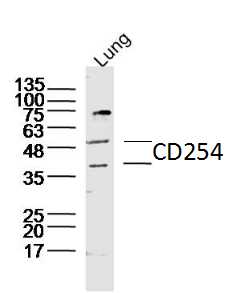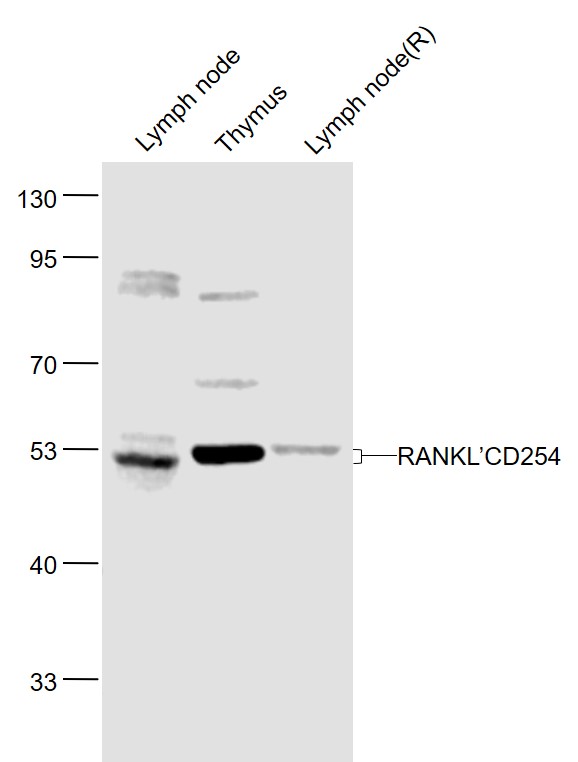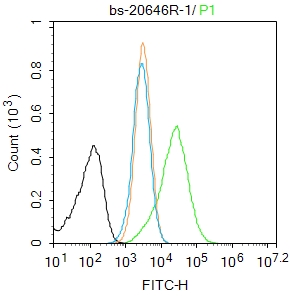
Rabbit Anti-RANKL/CD254 antibody
OPGL; CD254; hRANKL2; ODF; OPGL; Osteoclast differentiation factor; Osteoprotegerin ligand; RANKL; Receptor activator of nuclear factor kappa B ligand; sOdf; SOFA; TNF related activation induced cytokine; TNFSF 11; TNFSF11; TRANCE; Tumor necrosis factor l
View History [Clear]
Details
Product Name RANKL/CD254 Chinese Name 骨保护蛋白配体/破骨Cell differentiation因子抗体 Alias OPGL; CD254; hRANKL2; ODF; OPGL; Osteoclast differentiation factor; Osteoprotegerin ligand; RANKL; Receptor activator of nuclear factor kappa B ligand; sOdf; SOFA; TNF related activation induced cytokine; TNFSF 11; TNFSF11; TRANCE; Tumor necrosis factor ligand superfamily member 11; Osteoprotegerin Ligand; TNF11_HUMAN. literatures Research Area Tumour Cell biology immunology Developmental biology Immunogen Species Rabbit Clonality Polyclonal React Species Human, Mouse, Rat, (predicted: Dog, Pig, Cow, Horse, Rabbit, Zebrafish, ) Applications WB=1:500-2000 Flow-Cyt=1ug/Test
not yet tested in other applications.
optimal dilutions/concentrations should be determined by the end user.Theoretical molecular weight 35kDa Cellular localization cytoplasmic The cell membrane Secretory protein Form Liquid Concentration 1mg/ml immunogen KLH conjugated synthetic peptide derived from human RANKL/CD254: 41-140/317 Lsotype IgG Purification affinity purified by Protein A Buffer Solution 0.01M TBS(pH7.4) with 1% BSA, 0.03% Proclin300 and 50% Glycerol. Storage Shipped at 4℃. Store at -20 °C for one year. Avoid repeated freeze/thaw cycles. Attention This product as supplied is intended for research use only, not for use in human, therapeutic or diagnostic applications. PubMed PubMed Product Detail This gene encodes a member of the tumor necrosis factor (TNF) cytokine family which is a ligand for osteoprotegerin and functions as a key factor for osteoclast differentiation and activation. This protein was shown to be a dentritic cell survival factor and is involved in the regulation of T cell-dependent immune response. T cell activation was reported to induce expression of this gene and lead to an increase of osteoclastogenesis and bone loss. This protein was shown to activate antiapoptotic kinase AKT/PKB through a signaling complex involving SRC kinase and tumor necrosis factor receptor-associated factor (TRAF) 6, which indicated this protein may have a role in the regulation of cell apoptosis. Targeted disruption of the related gene in mice led to severe osteopetrosis and a lack of osteoclasts. The deficient mice exhibited defects in early differentiation of T and B lymphocytes, and failed to form lobulo-alveolar mammary structures during pregnancy. Two alternatively spliced transcript variants have been found. [provided by RefSeq, Jul 2008].
Function:
Cytokine that binds to TNFRSF11B/OPG and to TNFRSF11A/RANK. Osteoclast differentiation and activation factor. Augments the ability of dendritic cells to stimulate naive T-cell proliferation. May be an important regulator of interactions between T-cells and dendritic cells and may play a role in the regulation of the T-cell-dependent immune response. May also play an important role in enhanced bone-resorption in humoral hypercalcemia of malignancy.
Subcellular Location:
Cytoplasm; Secreted and Cell membrane.
Tissue Specificity:
Highest in the peripheral lymph nodes, weak in spleen, peripheral blood Leukocytes, bone marrow, heart, placenta, skeletal muscle, stomach and thyroid.
Post-translational modifications:
The soluble form of isoform 1 derives from the membrane form by proteolytic processing. The cleavage may be catalyzed by ADAM17.
DISEASE:
Defects in TNFSF11 are the cause of osteopetrosis autosomal recessive type 2 (OPTB2) [MIM:259710]; also known as osteoclast-poor osteopetrosis. Osteopetrosis is a rare genetic disease characterized by abnormally dense bone, due to defective resorption of immature bone. The disorder occurs in two forms: a severe autosomal recessive form occurring in utero, infancy, or childhood, and a benign autosomal dominant form occurring in adolescence or adulthood. Autosomal recessive osteopetrosis is usually associated with normal or elevated amount of non-functional osteoclasts. OPTB2 is characterized by paucity of osteoclasts, suggesting a molecular defect in osteoclast development.
Similarity:
Belongs to the tumor necrosis factor family.
SWISS:
O14788
Gene ID:
8600
Database links:Entrez Gene: 8600 Human
Entrez Gene: 21943 Mouse
Omim: 602642 Human
SwissProt: O14788 Human
SwissProt: O35235 Mouse
Unigene: 333791 Human
Unigene: 249221 Mouse
OPGL骨保护蛋白配体又称骨保护素配体(破骨细胞发育刺激因子)。属Tumour坏死因子TNF-a家族。
OPGL促进破骨细胞的分化和活性,而OPG抑制这些过程。骨髓瘤细胞影响骨髓中这两种蛋白的生理平衡,是发生溶骨性病变的根本所在。Product Picture
Lung (Mouse) Lysate at 40 ug
Primary: Anti-CD254 (SL20646R) at 1/300 dilution
Secondary: IRDye800CW Goat Anti-Rabbit IgG at 1/20000 dilution
Predicted band size: 35 kD
Observed band size: 37/50 kD
Sample:
Lymph node (Mouse) Lysate at 40 ug
Thymus (Mouse) Lysate at 40 ug
Lymph node (Rat) Lysate at 40 ug
Primary: Anti-RANKL'CD254 (SL20646R) at 1/500 dilution
Secondary: IRDye800CW Goat Anti-Rabbit IgG at 1/20000 dilution
Predicted band size: 37'50 kD
Observed band size: 50 kD
Blank control:HL-60.
Primary Antibody (green line): Rabbit Anti-RANKL/CD254 antibody (SL20646R)
Dilution: 1μg /10^6 cells;
Isotype Control Antibody (orange line): Rabbit IgG .
Secondary Antibody : Goat anti-rabbit IgG-AF488
Dilution: 1μg /test.
Protocol
The cells were fixed with 4% PFA (10min at room temperature)and then permeabilized with 0.1% PBST for 20 min at room temperature. The cells were then incubated in 5%BSA to block non-specific protein-protein interactions for 30 min at room temperature .Cells stained with Primary Antibody for 30 min at room temperature. The secondary antibody used for 40 min at room temperature. Acquisition of 20,000 events was performed.
References (0)
No References
Bought notes(bought amounts latest0)
No one bought this product
User Comment(Total0User Comment Num)
- No comment





 +86 571 56623320
+86 571 56623320
 +86 18668110335
+86 18668110335

